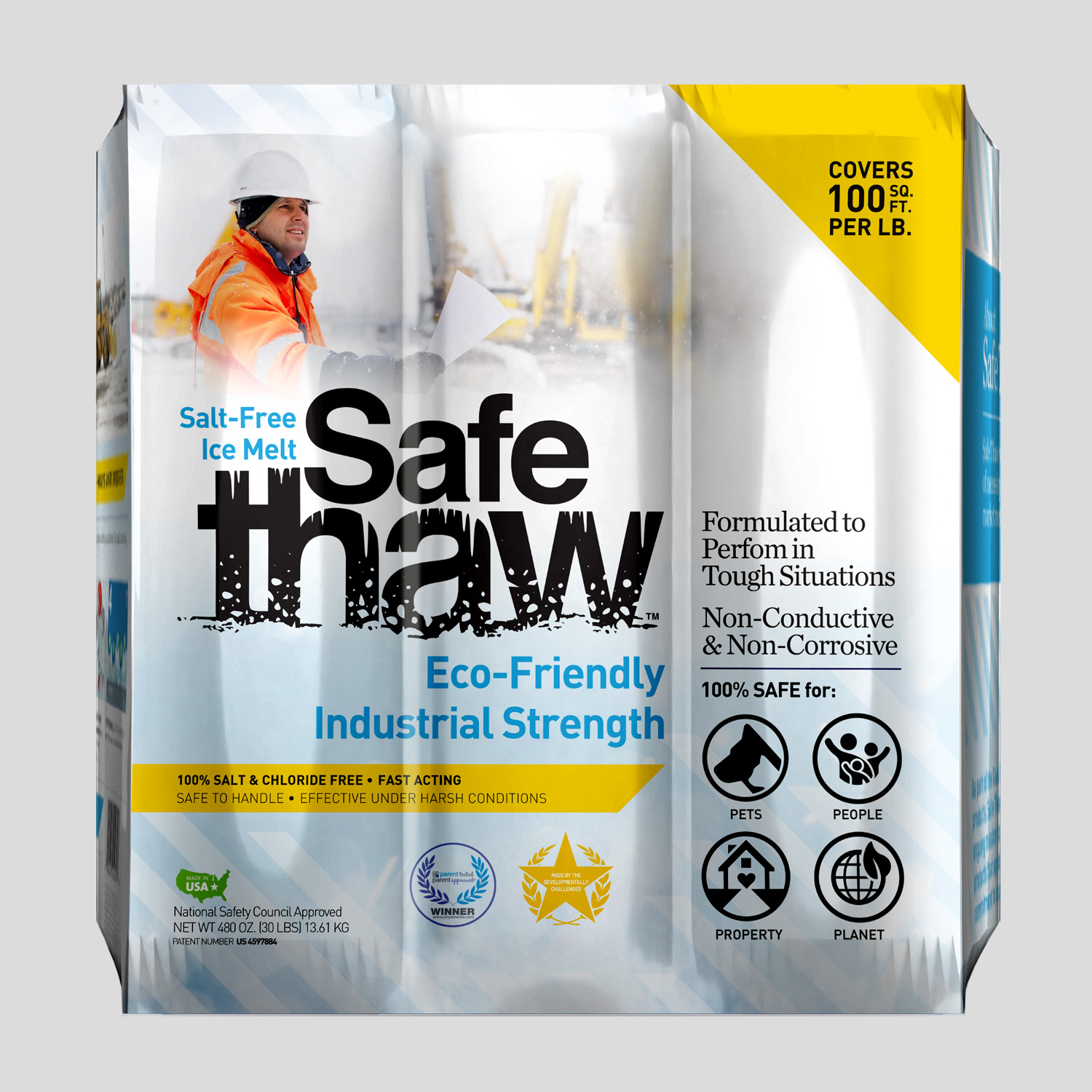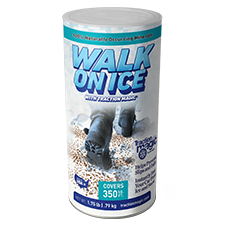5 Ice Melts You Can Trust To Be Safe For Concrete Surfaces

Hey there! As winter’s chill sets in, let’s have a real talk about a common headache for many of us: finding a safe ice melt for concrete surfaces. We all should be cautious about the ice melt we are using, one wrong decision can ruin your entire floor and driveway beauty and put a load on your wallet. So, let’s dive into the world of safe ice melt for concrete and figure out which concrete safe ice melter ones you can trust. We’ll also take a good, hard look at the not-so-great sides of each option (other than Safe Thaw, of course) because, let’s be honest, everything has its downsides.

Safe Thaw
Safe Thaw was created as the ice management solution for tough winter environments. Ideal in commercial and industrial properties, shops, government agencies, bridges, and construction.
Safe Thaw: Your Driveway’s Best Friend
Starting with a winner, we have Safe Thaw. This is like the superhero of ice melts when it comes to safe ice melt for concrete. It’s got a non-corrosive, chloride-free formula that’s like a gentle giant – tough on ice but kind on your driveway. Its patented formula – this cool blend of a modified crystalline amide core with special glycol admixture – makes it super effective without the drama of damaging your concrete. It’s like that reliable friend who always helps out but never causes trouble.
The Harsh Reality Of Salt-Based Melts
Now, about those salt-based ice melts. Sure, they’re the go-to for many folks, but here’s the deal – they can be rough on your concrete. They lead to scaling, cracking, all that nasty stuff you don’t want. It’s like using a harsh cleaner; sure, it gets rid of stains but at what cost to your stuff?
Calcium Chloride: Fast But Fierce
Next up, calcium chloride. It’s like that strong cup of coffee – kicks in fast but can be a bit too much. It’s great for melting ice quickly, but it’s also pretty fond of moisture, leading to a freeze-thaw cycle that can do a number on your concrete. Think of it like a powerful cleaning agent – effective, but it can fade your clothes over time.
Magnesium Chloride: A Milder Choice, Yet Not Perfect
Then there’s magnesium chloride. This one’s a bit gentler on concrete, but it’s not without its issues. If you use too much, you can still end up with some damage. It’s like that mild shampoo – good for your hair but might not get out the toughest grime.
Potassium Chloride: Not Too Harsh, Not Too Effective
Potassium chloride is another option. It’s less harsh on concrete, but it kinda throws in the towel when temperatures really dip. It’s like having a light jacket that’s good for fall but not quite up for a harsh winter.
100% salt & chloride-free, fast acting Ice Management Solution
Acetates: Fancy But Finicky
Acetates are like those high-end, fancy gadgets. They sound great and work well, but they can be pricey and might have some environmental drawbacks. It’s like buying that top-of-the-line appliance – looks impressive, but is it really necessary for everyday use?
Why Safe Thaw Wins The Day
When you line them all up, Safe Thaw is like that reliable all-season jacket – effective, versatile, and doesn’t let you down. It’s effective, safe for your concrete, and eco-friendly. It’s like choosing that one reliable tool in your shed that you know won’t let you down.
What Really Makes a Concrete Safe Ice Melter?
So now that we’ve sized up the usual suspects, let’s zoom out for a moment. What really makes a concrete safe ice melter different when the storms hit back-to-back and temperatures stay low for days? The truth is, not all “concrete-safe” labels mean the same thing. Some products throw that claim on the bag just because they’re “less harsh” than straight rock salt. But “less harsh” doesn’t equal safe.
Here’s the thing: Safe Thaw isn’t just “kinder” to your concrete; it’s actually designed from the ground up to avoid the chemical chain reaction that destroys surfaces. While salts and chlorides weaken concrete from the inside out, Safe Thaw creates a barrier effect that keeps the freeze-thaw cycle from digging in. And that’s not marketing fluff—it’s the reason so many industrial properties, government agencies, and even airports trust it over short-lived alternatives.
You could almost think of it like sunscreen for your driveway. You wouldn’t step into blazing sun without a layer of protection, right? In the same way, your driveway needs that shield in winter, not just a quick fix that leaves scars later.
Does Salt Ruin Concrete? Should you really be Worried?
At this point, you might still be wondering: does salt ruin concrete enough to really worry about? Let’s talk honestly. Salt itself doesn’t instantly chew up the surface. The real culprit is the way it pulls water into the pores of concrete. When that water freezes and expands, the pressure has only one way out—cracks. And once cracks form, it’s game over. Moisture keeps finding its way in, and every thaw-freeze cycle pushes those cracks wider.
So yes, salt does ruin concrete—it just does it quietly, over time. One winter may not show it, but after two or three, you’ll notice scaling, flaking, and uneven spots.
Safe Thaw flips that equation. Instead of drawing moisture into the slab, it keeps ice from bonding tightly in the first place. So when it melts, there’s no hidden damage working its way into the concrete’s pores. It’s the difference between using a cleaner that slowly eats your countertop versus one that leaves it untouched while still doing the job.
How To Repair Concrete Driveway Damage Once It Appears
But let’s say you’re already dealing with damage. Maybe past winters weren’t kind, and you’re staring at a driveway dotted with cracks or patches of rough, pitted surface. The question naturally becomes: how to repair concrete driveway issues without breaking the bank?
Deeper cracks, though, often require epoxy injections or patching with polymer-modified mixes. These repairs stop cracks from spreading, but they also highlight the need for prevention moving forward.
And here’s the critical part: if you go right back to salt or chloride melts after repairing, you’re undoing your own work. That’s like patching a roof and then leaving the window open in a storm. Choosing a concrete safe ice melter after repairing isn’t optional—it’s essential. It’s what keeps the same damage from cropping up again, saving you from repeating the cycle every year.
What’s the Right Temperature For Concrete To Cure: Why It Matters For Ice Melt
Here’s another question people often forget to ask: what’s the right temperature for concrete to cure, and why should I care during winter? The curing stage determines how tough your driveway will be for years to come. Ideally, concrete needs to cure at 50°F or higher for 28 days. If it cures in colder weather without proper insulation, it may never reach full strength.
Why does this matter for ice melt? Because weaker, under-cured concrete is far more vulnerable to chemicals and freeze-thaw damage. Even so-called “milder” deicers can wreak havoc on new driveways. That’s why Safe Thaw becomes the safer option right out of the gate.
So, if your driveway was poured recently or during cooler months, using chloride-based products is like throwing gasoline on a fire. Protecting it with a non-corrosive solution is the only way to preserve its strength long-term.
The Bigger Question: Are You Thinking Short-Term Or Long-Term?
At the end of the day, the decision comes down to mindset. Are you looking for the cheapest bag that works for one storm, or are you thinking about your driveway’s condition five winters from now? Because that’s the fork in the road.
Yes, you can save a few bucks by buying generic salt or a blend of chlorides. And yes, it will melt the ice quickly. But when you add up the cost of concrete repairs, landscaping replacements, rusted tools, and corroded vehicles, those savings disappear fast. A concrete safe ice melter isn’t just about surface safety—it’s about protecting everything connected to that surface.
And here’s the kicker: Safe Thaw isn’t just for homeowners. It’s trusted in commercial lots, bridges, and even transit areas where failure simply isn’t an option. If those heavy-duty environments rely on it, imagine the peace of mind it offers for your own driveway.
Conclusion
When you put it all together, the question isn’t “which ice melt works fastest” but “which ice melt keeps working without causing collateral damage?” Salts and chlorides may feel like quick wins, but they slowly chip away at the very surface you’re trying to protect. Safe Thaw, as a concrete safe ice melter, takes the long view. It answers the nagging questions—does salt ruin concrete, how to repair concrete driveway, what’s the right temperature for concrete to cure—by removing those risks altogether.
The choice is simple: skip the salts, stop the cycle of damage, and use Safe Thaw for real, lasting protection. Because when it comes to winter safety, it isn’t just about melting ice—it’s about preserving what matters most.
Try Also Our Other Winter Safety Products:
Safe Paw
The Original and #1 Selling Pet and Child Safe Ice Melt for over 20 years. Guaranteed environmentally safe –It won’t harm animals or children, and it won’t damage your property. That’s Safe Paw. Safe Paw can change how winter affects our planet.

Walk On Ice
The handy disposable canister can be taken everywhere, with the same 100% naturally occurring minerals that provide instant traction on ice or snow. Use it on sidewalks, steps, or as an instant traction agent for your car.



